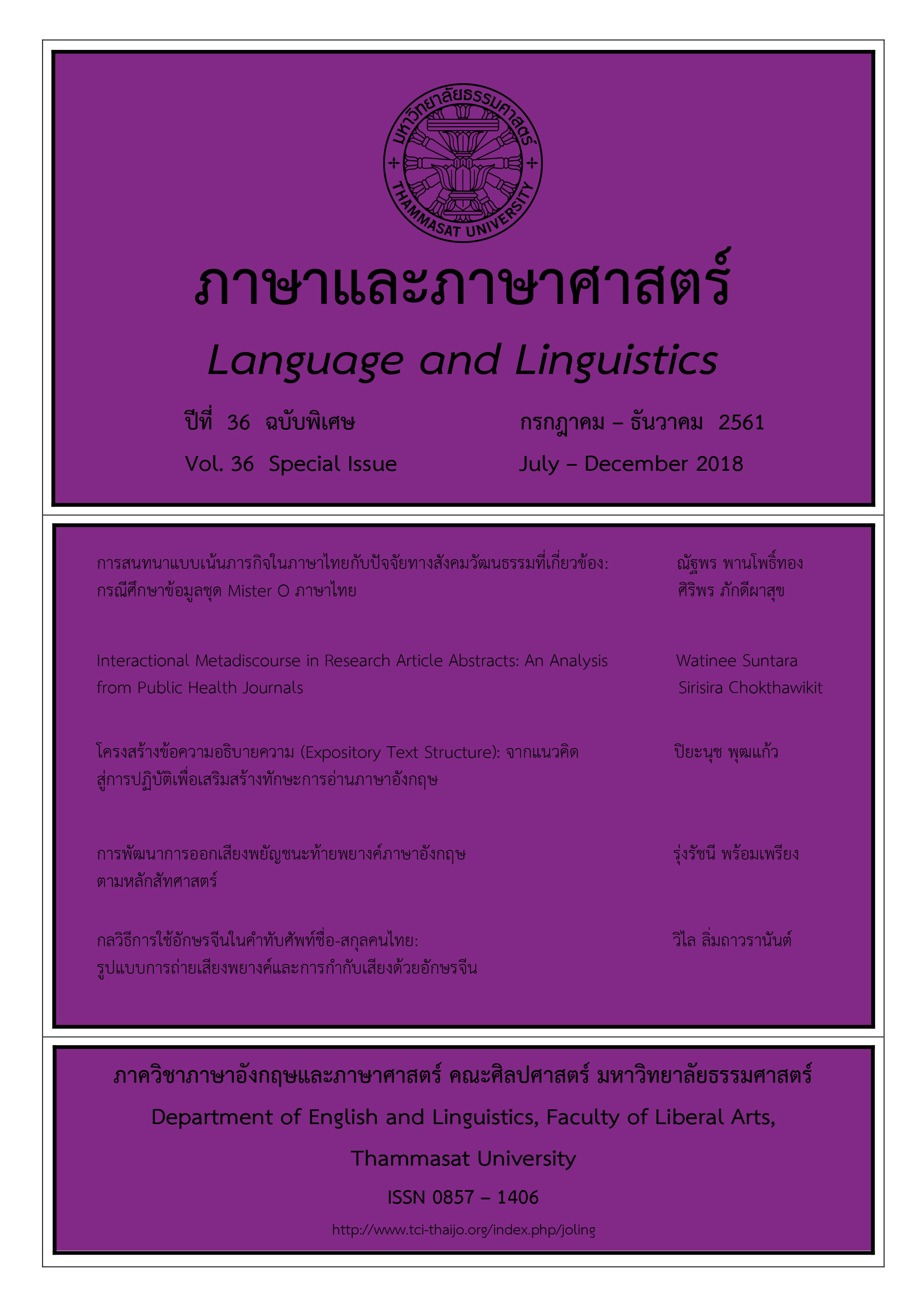Expository Text Structure: From Concept to Practice for the Enhancement of English Reading Skills
Main Article Content
Abstract
Reading texts in English is a part of an individual’s everyday life and often serves different purposes, such as learning courses based on an educational system, pursuing knowledge-based routines, applying information for quality of life, and assessing English proficiency in test format. Most English texts are written with an expository text structure, whereby the text is systematically constructed with an internal structure and aims to provide information about its topic to the reader. The expository text structures commonly found in English language texts can be classified into five types: description, sequence, problem–solution, cause–effect, and compare/contrast. Research findings reflect that a reader’s learning experience with a variety of different types of expository text structure plays a pivotal role in enhancing reading comprehension. Readers who are familiar with a variety of different types of expository text structure will read strategically and extract key points from their readings. By contrast, readers who are not aware of the text structure can tend to read without using reading strategies. Educators have suggested that experience with and training on a variety of different types of expository text structure will improve readers’ reading comprehension for more complicated English texts.
Article Details
บทความทุกบทความเป็นลิขสิทธิ์ของภาษาและภาษาศาสตร์
References
(วิทยานิพนธ์ปริญญามหาบัณฑิต). มหาวิทยาลัยเกษตรศาสตร์, กรุงเทพฯ.
เกศินี กูลพฤกษี. (2555). ผลสัมฤทธิ์ของการอ่านภาษาอังกฤษที่มีโครงสร้างบทอ่านเชิงความเรียง โดยการสร้างแผนภาพลำดับ
ความคิดในการวิเคราะห์โครงสร้างบทอ่าน. สืบค้นจากhttps://www.social.rbru.ac.th/activity/Research%20T
/Research3.pdf.
เกศินี กูลพฤกษี, และกรรณิการ์ เผือกนาผล. (2556). การศึกษาความสามารถในการวิเคราะห์โครงสร้างบทอ่านเชิงความเรียง
ของนักศึกษาชั้นปีที่ 2 สาขาวิชาภาษาอังกฤษธุรกิจ คณะมนุษยศาสตร์และสังคมศาสตร์ มหาวิทยาลัยราชภัฏรำไพพรรณี.
วารสารสังคมศาสตร์ มหาวิทยาลัยศรีนครินทรวิโรฒ, 16. สืบค้นจาก https://ejournals.swu.ac.th/index.php/JOS/article
/view/3805/3794.
นพมาศ หงษาชาติ. (2556). ความสามารถด้านการอ่านของนักศึกษาสาขาวิชาภาษาอังกฤษ
มหาวิทยาลัยราชภัฏราชนครินทร์. ฉะเชิงเทรา: มหาวิทยาลัยราชภัฏราชนครินทร์.
ประชาคมอาเซียน.net. (2557). องค์ความรู้ประชาคมเศรษฐกิจอาเซียน. สืบค้นจาก https://www.thai-aec.com/.
ปิยะนุช พุฒแก้ว. (2547). การเชื่อมโยงองค์ประกอบในการอ่าน (A Discourse Approach in Reading). ฉะเชิงเทรา:
มหาวิทยาลัยราชภัฏราชนครินทร์. (เอกสารอัดสำเนา)
______. (2557ก). การพัฒนาโมเดลกลวิธีการอ่านสำหรับผู้เรียนภาษาอังกฤษในฐานะภาษาต่างประเทศ. วารสารวิชาการ
มนุษยศาสตร์และสังคมศาสตร์ มหาวิทยาลัยบูรพา. 22(38), 111-132.
______. (2557ข). การพัฒนาโมเดลกลวิธีการอ่านสำหรับผู้เรียนภาษาอังกฤษในฐานะภาษาต่างประเทศ. ฉะเชิงเทรา:
มหาวิทยาลัยราชภัฏราชนครินทร์. (เอกสารอัดสำเนา)
Akhondi, M., Malayeri, F. A., & Samad, A. A. (2014). How to Teach Expository Text Structure to Facilitate
Reading Comprehension. Retrieved from https://www.readingrockets.org/article/52251.
Beyer, J. (2007). Strategies for Helping Struggling Readers Comprehend Expository Text. Retrieved from
https://www.lynchburg.edu/wp-content/uploads/volume-4-2009/BeyerJ-Strategies-Helping-Struggling-Readers-
Expository-Text.pdf
Bradley, M. L. (2010). The Impact of Intermediate Students’ Awareness and Use of Text Structure in
Comprehending Expository Text and Its Implications for Classroom Instruction (Master’s Thesis).
Retrieved from Northern Michican University. https://www.nmu.edu/sites/DrupalEducation/files/UserFiles/Files
/Pre-Drupal/SiteSections/Students/GradPapers/Projects/Bradley_Michelle_MP.pdf.
Carter, C. S. (2014). Using Technology and Traditional Instruction to Teach Expository Text in the Sixth Grade
Reading Classroom: A Quasi-Experimental Study. Retrieved from https://digitalcommons.georgiasouthern.edu
/cgi/viewcontent.cgi?article=1012&context=edu-papers.
Dymoick, S. (2005). Teaching expository text structure awareness. The Reading Teacher. 59(2), 177-181.
Iwai, Y. (2007). Developing ESL/EFL Learners’ Reading Comprehension of Expository Texts. The Internet TESL
Journal, 13(7). Retrieved from https://iteslj.org/Techniques/Iwai-ExpositoryTexts.html.
Meyer, B. J. F., & Ray, M. N. (2011). Structure strategy interventions: Increasing reading comprehension of
expository text. International Electronic Journal of Elementary Education. 4(1), 127-152.
National Education Association. (2014). Using Text Structure. Retrieved from https://www.nea.org/tools/using-text-
structure.html.
Orcutt, K. (2014). 20 Strategies to Teach Text Structure. Retrieved from https://www.stclair.k12.il.us/ccore
/ELAShifts/documents/Info%20Text/Textstructure_resources.pdf
Perry, D. (2013). Comprehension strategies while reading expository texts in Spanish (L1) and English (L2).
Psicología Educativa, 19(02), 75-81. Retrieved from https://pse.elsevier.es/en/comprehension-strategies-while-
reading expository/articulo/90262348/.
Ray, M. N., & Meyer, B. J. F. (2011). Individual differences in children’s knowledge of expository text structures: A
review of literature. International Electronic Journal of Elementary Education. 4(1), 67-82.
Smith, L. C., & Mare, N. N. (1995). Issues for Today. Boston, MA: Heinle & Heinle Publishers.
Veveiros, J. C. (2010). The Effects of Teaching Expository Reading Strategies during Science Instruction on
Content Knowledge and Overall Reading Ability (Master’s Thesis). Retrieved from California State University.
https://csus-dspace.calstate.edu/bitstream/handle/10211.9/587/Jennifer%20Veveiros%20-%20Final
%20%20Formatted%20Revised.pdf?sequence=1


